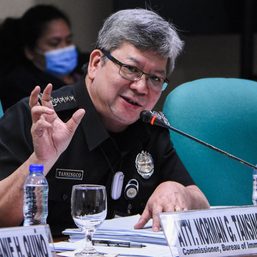SUMMARY
This is AI generated summarization, which may have errors. For context, always refer to the full article.

Graduation day is the highlight of our lives as students. It’s our happily-ever-after – the culmination of years of hard work and perseverance to succeed and survive. For the few minutes that we get to be onstage, we get to be on top of the world. Hence, we strive to be our best selves to make the moment count. We wear our nicest clothes underneath our togas. We style our hair, maybe even put on a bit of makeup.
However, not everyone has that luxury. For transgender kids, graduation is a waking nightmare. It’s the day when they are publicly called with their dead names and forced to present themselves onstage as someone who does not align with their actual gender identity.
In a viral Facebook post, Miss Trans Global 2020 Mela Franco Habijan shared the story of four transgender women – Nicole, Kendi, Jade, and Rey – who were prohibited from marching in their graduation unless they cut their hair and don male clothing. Upon hearing their predicament, Habijan set up a photo shoot to celebrate their true selves in the spotlight and “remind them of their worth as trans people.” On top of that, she also reached out to various Department of Education executives to ensure that the four girls were given the graduation ceremony that they deserved.
Her unyielding efforts sparked a light that eventually ignited into a brighter flame. It empowered other members of the community to speak up and fight for their rightful spot on the graduation stage.
She’s no damsel-in-distress
Lhanz Kuina Suruiz, a 18-year-old transgender woman, was one of them.
“Malaking tulong talaga na merong bumoboses laban sa mga diskriminasyon na nararanasan ng mga kapatid natin sa LGBTQIA+ community (It really helps that there is someone who voices out our concerns regarding the discrimination faced by our siblings in the LGBTQ+ community),” said Suruiz.
She has always been loud and proud of her gender expression and identity. In fact, she is never one to shy away from any chance to wave the trans flag and advance the call for equality.
Thankfully, her inner circle at school, which consists of her friends, classmates, and teachers, has always been supportive. The constant stream of love, acceptance, and encouragement that she got from them inspired her to flourish both as an individual and as a student. She successfully completed her senior year of high school with honors.
Despite this, Suruiz confessed that she still harbored uncertainty. The entirety of her senior high school career was spent online due to COVID-19. Because of that, she was reprieved from the stringent rules that typically characterize the Philippine academe. Had the circumstances been different, would she be as accepted and liberated as she is now?
“Hindi naman ako na-discriminate, siguro virtual din kasi. Wish ko lang na kapag face-to-face na ay payagan din nila yung ibang trans kids na malayang i-express yung sarili nila (I was never discriminated, probably because of our virtual setup. I just wish that, come face-to-face classes, they also allow other trans kids to freely express themselves),” she explained.
This uncertainty almost caused her to opt out of her graduation. Days before the event, she was asked for her name and her graduation picture for their virtual ceremony. Suruiz, of course, wanted her frame to reflect her lived identity, but she was unsure if the school administrators would be welcome to accommodate that.
“Kung hindi sila pumayag, sabi ko sa sarili ko, okay lang sa’kin kahit ‘di na nila i-flash yung picture ko. Kaysa naman mag-pasa ako ng picture na hindi ko naman nararamdaman na ako ‘yun (If they refused, I told myself, it’s okay if they don’t flash my picture at all. I’d prefer that instead of giving them a picture that doesn’t reflect who I really am),” Suruiz recounted.
Suruiz took the chance and forwarded her concern. She cited the regional memorandum issued by DepEd CALABARZON and DepEd NCR on June 27 calling for schools to “promote gender equality, gender equity, gender sensitivity, non-discrimination, and human rights” by respecting the gender expression of each student. The memorandum serves as a reiteration of the Gender-Responsive Basic Education Policy under DepEd Order No. 32, s. 2017.
Fortunately, Suruiz was given a happy ending. The school granted their permission after a faculty meeting. Furthermore, her appeal also allowed other trangender kids to have the same opportunity by extension.
“I felt grateful and hopeful na magtuloy-tuloy na ang pagiging inclusive (I felt grateful and hopeful that this journey towards inclusivity would be continued),” said Suruiz.
Princesses are not always saved
Meanwhile, Habijan’s post stirred different emotions in Ysrael Ogay, a 21-year-old trans woman. It brought back the bitter memories of her own graduation years ago, when she was prohibited to come as her lived identity. She recounted how she was pulled aside from their graduation practice and got told that she needed to cut her hair if she wanted to march.
Sadly, no fairy godmother nor knight in shining armor came to her rescue.
“Nagpagupit na lang ako kasi, syempre, gusto ko rin namang grumaduate. Wala naman akong kasama na magsusulong dun sa hinaing ko eh. Umiyak ako noon nang sobra (I got a haircut because, of course, I still wanted to graduate. I had no one to back me up on my appeal. I cried really hard back then),” said Ogay.
She confessed how that event triggered her struggle with gender dysphoria. That one act of othering gave her a permanent reminder that she was different.
“Kahit ngayon, naapektuhan pa rin ako. Nakakaramdam pa rin ako ng anxiety at nagkaroon din ako ng mababang self-esteem. Tuwing may pumipigil sakin na i-express yung sarili ko ay nawawalan ako ng confidence. Naalala ko yung social stigma na kinakaharap namin mga transgender.
(Until now, I’m still affected by it. I still feel anxious and have developed low self-esteem. Everytime that something inhibits me from showing who I truly am, I lose my confidence. I’m reminded of the social stigma that we face as transgenders),” Ogay tearfully admitted.
“Sinasabi nilang pangalawang tahanan ang paaralan, bakit ipinaparamdam sa’min na hindi kami ligtas at tanggap (They say that schools are our second homes, so why do they makes us feel unsafe and unwelcome)?”
According to National Health Service UK, gender dysphoria is characterized as the distress that a person might feel when their biological sex and gender identity does not match. One’s biological sex refers to their assigned sex at birth (i.e. male or female). On the other hand, one’s gender identity refers to the learned behaviors that they have developed in response to the prevalent social standards of masculinity and femininity that they have been exposed to. The level of distress could vary, but there are cases when it becomes so overwhelming that it affects one’s daily life.
Ogay refused to let moment that be the end of her. Instead, she saw it as a wake-up call. She realized then that there were thousands of LGBTQ+ students just like her who have been rendered helpless by the heteronormative standards underlined in the rules of many academic institutions.
“Nakita ko yung need para maging vocal tayo sa estado natin sa lipunan. Hindi tayo makakalaya kung uupo lang tayo at maghihintay (I saw the need for us to be vocal about our status in society. We will never be free if we just sit around and wait),” she explained.
Since then, she vowed to actively participate in the fight for gender equality. In the process, she learned how to save herself as well as others.
Ogay encourages every member of the LGBTQ+ community along with their allies to do the same.
“Magsalita sila kapag may mali, basta alam nilang wala namang ibang ginagawa kundi maging totoo lang sa sarili. Ipaglaban mo kung kinukutya siya. Ikaw na nakakaalam ng SOGIE, ipaalam mo sa hindi nakakaalam (Speak up when something is wrong, as long as they know that they’re just staying true to themselves. Fight for those who are discriminated against. If you are knowledgeable about SOGIE, educate those who are not.),” she asserted.
Now, she is already a college student, enrolled in a school that celebrates her identity and accepts her for who she is. There, she is given the liberty to wear her hair in whatever style, color, or length she wants. This freedom, paired with her newfound sense of purpose, makes her glow all the brighter.
The grim reality for trans kids
On paper, academic institutions promise a commitment to gender equality. DepEd’s Mission reads that “students learn in child-friendly, gender-sensitive, safe, and motivating environment.” Even the Gender-Responsive Basic Education Policy referenced in the aforementioned memoranda, which aims to “ensure a gender-responsive physical and social learning environment that promotes respect for all people and has zero tolerance for all forms of discrimination,” has been around since 2017.
In practice, however, this is not always observed. In schools, almost everything is gendered under the traditional binary system – bathrooms, uniforms, seating arrangements, lines during the flag ceremony, and more. In most of these institutions, they deny their students the liberty of choosing a gender expression that does not align with their biological sex.
At the moment, no national legislation adequately protects them from these kinds of covert and non-violent discrimination and micro-aggression either. The SOGIE equality bill is still stalled in the Senate. Moreover, although the Anti-Bullying Law of 2013 recognizes gender-based bullying as “any act that humiates or excludes a person on the basis of perceived or actual sexual orientation and gender identity (SOGI)”, it does not cover cases where the bullying is ingrained within the internal policies of their respective schools.
An arduous journey before the happily ever after
There’s still a long way to go. Ogay, Suruiz, and thousands of other LGBTQ+ students still yearn for the day when every student, regardless of gender identity, is given the opportunity to shine not only at graduation but also in their entire stay within the academe. They long for the day when stories of acceptance become the norm rather than the exception.
“Hindi naman kami humihingi nang sobra. Hayaan lang nila kami maging kami. Kung hindi ikaw yung nasa sapatos nung naaapi, try mo isukat nang maranasan mo at maintindihan mo kung bakit sila lumalaban (We’re not asking for much. Just let us be ourselves. If you’re not in the shoes of the oppressed, try putting yourself there so you can experience and understand what they’re fighting for),” stressed Ogay.
“We just want to have a learning environment where we feel safe and secure. Help us end the discrimination and make the school a safe place for every student and teacher,” Suruiz added. – Rappler.com
Beatriz Joyce Bertuldo is a Rappler intern.
Add a comment
How does this make you feel?





There are no comments yet. Add your comment to start the conversation.